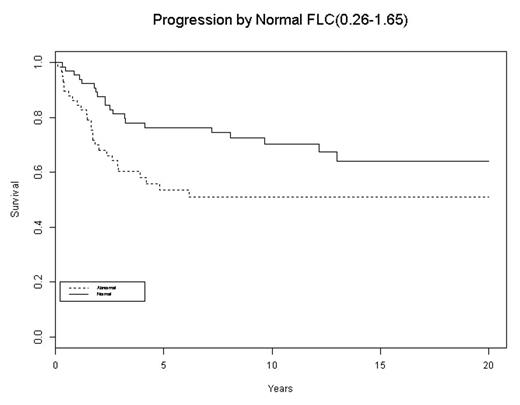Abstract
Background: Solitary plasmacytoma of bone (SBP) is a localized collection of monoclonal plasma cells that is potentially curable with local radiation therapy but associated with a high risk of progression to multiple myeloma. We hypothesized that an abnormal immunoglobulin free light (FLC) ratio at diagnosis may be a prognostic indicator of transformation risk.
Methods: We identified a cohort of 133 patients with SBP for whom stored serum taken at the time of diagnosis was available. The diagnosis was ascertained and serum FLC determined in 126 patients.
Results: From this cohort, 48 patients have progressed to myeloma and the median time to progression among those who progressed was 1.9 years. On univariate analysis, age (p<0.001), gender (p=0.035), abnormal FLC ratio at diagnosis (p=0.009) and persistence of serum or urine M-protein after therapy (p=0.0070 were all associated with a shorter overall survival (OS) and time to progression to multiple myeloma.
Progression by Normal FLC(0.26–1.65)
On multivariate analysis, an abnormal FLC ratio retained its independence in a model that includes age at diagnosis but lost its significance when combined with persistence of the serum or urine M-protein. However, serum or urine M-proteins are not detectable in a significant number of patients with SBP and therefore not informative.
Conclusion: The FLC ratio at the time of diagnosis of SBP is a powerful predictor of risk and a useful aid to management of patients with this condition.
Author notes
Corresponding author


This feature is available to Subscribers Only
Sign In or Create an Account Close Modal